An ‘E-flat Major Motif’?
Thoughts on Correlation between Choice of Key and Thematic Elements in Mozart’s Music
Uri Rom
This is an abridged version of the article »Ein ›Es-Dur-Gedanke‹? Zum Zusammenhang von Motivik und Tonart bei Mozart«, published in the Zeitschrift der Gesellschaft für Musiktheorie 6/1 (2009) and available through the following Internet link: http://www.gmth.de/zeitschrift/ausgabe-6-1-2009/inhalt.aspx.
Was Mozart’s choice of key a matter of merely fixing an ‘external’ parameter of a composition, its exact location within a given space of possibilities, or does the employment of a specific key in Mozart’s works also bear substantial implications on the music written in it? Based on an examination of the occurrences of a melodic six note motif in Mozart’s works (see Example 1), I try in this article to establish a correlation between this motif and the key of E-flat major. Taking this case as a point of departure, I attempt to address the general issue of Mozart’s choice of keys and its relation to concrete structural elements in his music.
During the twentieth century, the question of Mozart’s use of keys has been approached mainly from the point of view of traditional key characteristics, a discipline assigning different expressive attributes to specific keys (a few examples may include F.O. Souper 1933, Alec Hyatt-King 1937, Roland Tenschert 1953, Martin Chusid 1968, Petra Bockholdt-Weber 2003 and Steven B. Jan 1995 – the latter publication is mainly occupied with structural aspects). The discipline of key characteristics, going back to the seventeenth and eighteenth centuries, figures in the writings of Mozart’s predecessors and contemporaries (e.g. Johann Mattheson 1713, pp. 231–253, Christian Friedrich Daniel Schubart 1806, pp. 261–265), however, there is no direct evidence that Mozart actually composed with key characteristics in mind. A short footnote in Leopold Mozart’s Violinschule (Leopold Mozart 1756, p. 59, fn. 1) betrays the latter’s pragmatic approach; Leopold seems to acknowledge the existence of key characteristics, but not to attach to them any major aesthetic significance.
Against this backdrop, it seems appropriate to seek a different approach towards Mozart’s use of keys, an approach based on an analytical evaluation of structural aspects of his music. One of the first contributions to this approach may be seen in Wilhelm Gloede’s article “Motivstruktur und Tonart bei Mozart” (“Motif Structure and Key in Mozart’s Music”, 1993). Explicitly rejecting key characteristics as an inadequate framework for considering Mozart’s use of keys, the author presents five motifs which seem to entertain a close relationship with specific keys. The current examination of the instances of the motif in Mozart’s works shown in Example 1 generally follows Gloede’s example, but extends the inquiry’s scope, which is in Gloede mainly restricted to the beginnings of movements (or of large structural units), to include Mozart’s oeuvre in its entirety.

Example 1: The six note motif (shown in C major)
The six note motif in question appears around fifty times in Mozart’s works, but it is mainly the ‘pure’ form of the motif, without any ornaments, that will occupy us here. The literalness of the employment of the motif also plays a decisive role in establishing its relation to the key of E-flat major. The eight unornamented occurrences of the motif are listed in Table 1; the corresponding ‘main’ instances (i.e., the first instances in each of the listed movements) appear in Example 2. Most of the listed occurrences are already referred to by earlier studies (e.g. Otto Jahn 1856–59, p. 633, fn. 50, Alexander Ulibischeff 1859, 3. vol., pp. 109–110, Alfred Heuß 1930/31, pp. 188–189, Ellwood Derr 1997, p. 289 and Joachim Brügge 1992, pp. 79–80), however, the representation in Table 1 seems to be the first comprehensive survey of the phenomenon in Mozart’s complete oeuvre.
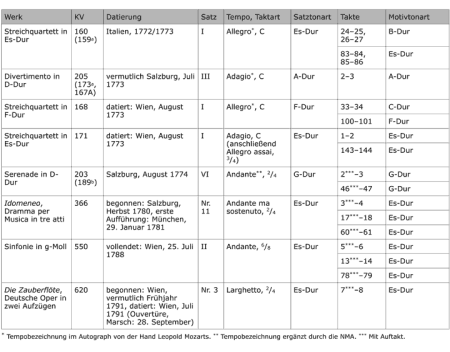
Table 1: Unornamented instances of the six notes motif in Mozart’s complete works
Example 2: Main instances of the six note motif
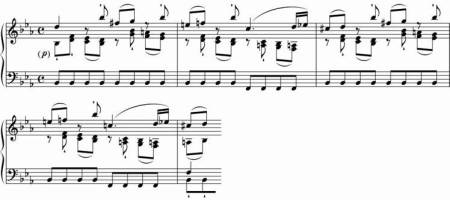
Example 2a: W.A. Mozart, string Quartet in E-flat major K.160 (159a), 1st movement, Allegro, mm. 24–28

Example 2b: W.A. Mozart, Divertimento in D major K.205 (173a, 167A), 3rd movement, Adagio, mm. 1–4 (violin, viola and bass)

Example 2c: W.A. Mozart, String Quartet in F major K.168, 1st movement, Allegro, mm. 31–35

Example 2d: W.A. Mozart, string Quartet in E-flat major K.171, 1st movement, Adagio-Introduction, mm. 1–8
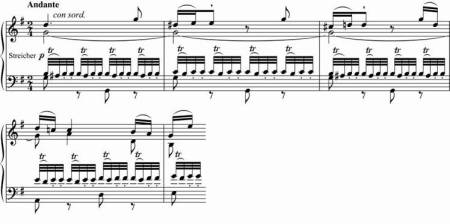
Example 2e: W.A. Mozart, Serenade in D major K.203 (189b), 4th movement, (Andante?), mm. 1–5

Example 2f: W.A. Mozart, Idomeneo, Dramma per Musica in tre atti K.366, No. 11, Andante ma sostenuto, mm. 1–6
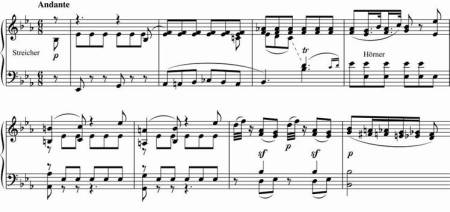
Example 2g: W.A. Mozart, Symphony in G Minor K.550, 2nd movement, Andante, mm. 1–8
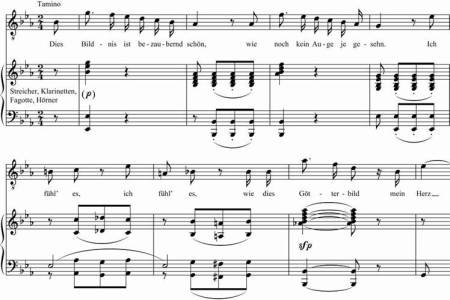
Example 2h: W.A. Mozart, Die Zauberflöte, Deutsche Oper in zwei Aufzügen K.620, No. 3, Larghetto, mm. 3–10
The instance in the third movement of K.205 is slightly ornamented, in that the first note of the six tone sequence is broken into a leap connecting two pitches an octave apart. Conversely, the anticipations in K.205 and in K.203 could hardly be considered a significant deviation from the unornamented form; two later instances of the motif in Ilia’s aria contain similar anticipations, whereas the first occurrence in the orchestral introduction of the aria (Example 2f) employs none – the coexistence of equivalent versions with and without anticipations in the same piece shows the modification resulting from the addition of anticipations to be rather insignificant for the definition of the melodic model in question.
The eight main occurrences in Example 2 show an outstanding dominance of the key of E-flat major; four of the eight cases share this key. Considering that E-flat major is one of the less frequent among Mozart’s seven common keys (still less frequent are G and A major), these findings seem even more striking.
A detailed analysis of the eight instances in Example 2 underlines the existence of three different types among them. The early Allegro instances in the string quartets K.160 and K.168 seem hardly related to the remainder of the cases, which are characterized by slower tempi. The slow introduction in K.171 constitutes a special case, introducing the motif in majestic quarter notes, completely unharmonized and beginning on a strong beat. The remaining five instances are characterized by lyrical breadth and moderate to slow tempi. Three of them are in E-flat major: the second movement of K.550 and the two arias from Idomeneo and Die Zauberflöte. A detailed harmonic analysis shows that these three instances further resemble one another in that the subdominant harmony, supporting tones 2–4 of the six tone sequence, is strongly articulated with an A-flat in the bass (in the two other lyrical instances, K.203 in G major and K.205 in A major, the bass sticks to the tonic throughout the presentation of the motif, belittling, as it were, the weight of the subdominant).
In view of the above, it seems fit to describe the motif in Example 1 in its unornamented form as a melodic structure with a strong affinity to E-flat major. What happens if we attempt to interfere with the original sequence? Let us first consider in what ways this could be achieved. The six note motif may be split into various structural strata in the following manner:
 Example 3: Structural strata of the six notes motif
Example 3: Structural strata of the six notes motif
The first and the fourth note can be seen as harmonic and metric upbeats as well as a prolongation of the tonic; notes 2 and 5 are introduced as chromatic suspensions, resolving into notes 3 and 6 respectively (the unharmonized instance in K.171, beginning on a strong beat, is an exception to this rule). There are many ways to vary this basic structure. Substituting the chromatic suspensions from below for diatonic ones from above yields a melodic line such as the one in K.283. As opposed to the yearning, melancholy character of the original structure this variant is rather boisterous:
 Example 4: W.A. Mozart, Piano Sonata in G major K.283 (289h), 1st movement, Allegro, mm. 1–6
Example 4: W.A. Mozart, Piano Sonata in G major K.283 (289h), 1st movement, Allegro, mm. 1–6
Substituting one of the upbeat notes and embellishing the other one may lead to the following solution, probably the earliest among Mozart’s works:
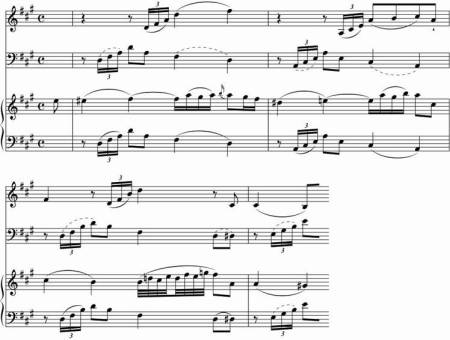 Example 5: W.A. Mozart, Sonata for Piano, Violin (or Flute) and Violoncello in A major K.12, 1st movement, Andante, mm. 5–8
Example 5: W.A. Mozart, Sonata for Piano, Violin (or Flute) and Violoncello in A major K.12, 1st movement, Andante, mm. 5–8
In addition, there are a few dozens of other melodic formulations more or less closely related to the original motif. This fact shows clearly that restricting the findings in Table 1 to ‘unornamented’ instances constitutes an essential measure in order to establish a connection between the melodic structure in question and the key of E-flat major. Small licenses in the original model definition of the motif are enough in order to expand the group in such a way that no affinity to whatever key can be determined.
This, in turn, seems to indicate a crucial trait in Mozart’s attitude towards melodic schemata in general. If we accept the correlation between key and melodic structure in Table 1 to be more than a ‘happy coincidence’, we must assume that Mozart’s mental image of the ‘E-flat motif’ in question (and perhaps of other motifs as well) was pinpointed to its literal, ‘pure’ form, since even small changes led to instances of a different – or of no – key orientation.
Three instances that present the original six note motif in an only slightly modified form deserve individual consideration. Built into the theme of the oboe quartet K.370 (Example 6a), the motif is preceded by a circulatio figure and has its first and fourth tones split in two ‘elegant’ eight notes. The theme of the solo piano entry in the first movement of K.413 (Example 6b) renounces the circulatio figure of K.370, maintaining, however, the ‘double upbeat’ (on the basis of these two examples, it is tempting to see a connection between the motif variant with the double upbeat and the key of F major). Finally, no. 10 of the minuet series K.585 (Example 6c) presents the motif in E-flat major, reiterating tones 1 and 4 of the sequence in fiery dotted rhythm. Considering that these three instances differ from the ‘literal’ ones in Example 2 mainly by allowing for additional tone repetitions, they seem close enough to the original melodic structure to justify their inclusion in the evaluation of the key orientation of the group as a whole. However, broadening the original group of instances along these lines will only slightly affect the ‘hegemony’ of E-flat major among its members.
Example 6: Slightly modified instances of the six notes motif
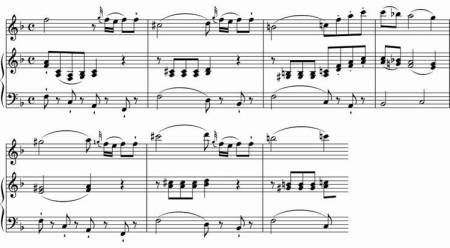
Example 6a: W.A. Mozart, Oboe Quartet K.370 (368b) in F major, 1st movement, Allegro, mm. 8–14

Example 6b: W.A. Mozart, Piano Concerto in F major K.413, 1st movement, Allegro, theme of the solo entry, mm. 56–62
(also corresponding to mm. 235–241)
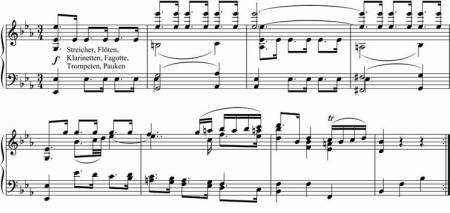 Example 6c: W.A. Mozart, Minuet K.585 No. 10, mm. 1–8
Example 6c: W.A. Mozart, Minuet K.585 No. 10, mm. 1–8
The fact that a time interval of about 18 years spans the E-flat major occurrences of the six tone motif in Mozart’s works (from K.171 to Die Zauberflöte) raises the question of how and at what point the connection between key and melodic structure may have formed in the first place. To a certain extent, it seems plausible to assume that a correlation of such persistence may also reach deep into the past. On the basis of some chronological considerations, it is possible to show that – other than the ‘official’ dating in Table 1 suggests – Mozart may have been occupied with the conception of K.171 prior to the (hasty) composition of K.205. This hypothetical order of events makes it possible to identify the E-flat major instance in K.171 as the first instance of the motif in slow tempo (the two instances in fast tempo in K.160 and in K.168 are not taken into account in this context). Whatever its origin, the correlation between key and melodic structure seems to have intensified throughout Mozart’s creative career; the later one looks, the bigger the chances to encounter cases confirming it. At the end, even the last of the ‘slightly modified’ occurrences, the minuet K.585/10, succumbs to the ‘gravitational field’ exerted by E-flat major.
These findings agree with Steven B. Jan’s conclusions based on his examination of Mozart’s works in G minor:
On the basis of the areas of enquiry chosen […], it is clear from the summary that there is no career–wide or pervasive objective/structural characterisation of G minor in Mozart. On the other hand, it is possible to argue that the summary shows [that] increasingly towards the end of his life the composer was moving toward such a characterisation. (Jan 1995, p. 319)
Considering Mozart’s move towards a stronger correlation between key and structural elements as a process, it seems appropriate to describe it in terms of ‘fulfillment’ of a key’s potential; at the same time this process involves a narrowing down of the variety of possibilities to compose in a given key. It is hardly surprising that the process should further reach its final goal in the Zauberflöte, a work that, probably more than any other one by Mozart, could be regarded as a compendium of the composer’s motifs and types (compare Ludwig Finscher 1985, p. 278).
Generalizing from the correlation observed in the case of the six note motif between key and concrete structural elements, one may ask whether this phenomenon is unique to Mozart, or whether it may be seen in a broader context, involving also other composers of the First Viennese School (or even other composers still). An extensive research on the oeuvre of each of the composers in question might be necessary in order to answer this question, although some positive results concerning Haydn and Beethoven may be gathered from existing studies (compare Michael C. Tusa 1993, Petra Bockholdt-Weber 1990, James Webster 1991, p. 172).
In this context, one may further question the ‘source’ of the six tone motive and its relation to E-flat major. Did Mozart come upon this motif – either in its fast version in K.160/I or in the slow one in K.171/I – of his own, or was he following a model? The intriguing truth is that among the compositions Mozart may have heard during the 1760ieth–1770ieth there are no less than four works containing the six tone motive in its ‘pure’ form, on top of everything, three of these works are in E-flat major.
While eight years old Wolfgang was staying in London with his family for parts of the years 1764 and 1765, Johann Christian Bach’s symphonies op. 3 were performed and published there (it seems that all six symphonies originate form Bach’s earlier period in Italy, see Ernest Warburton 1984). Example 7 shows the beginning of the second movement of op. 3, no. 4, an Andantino, sempre piano in E-flat major; the six note motif appears here at the position of the sixth and seventh phrase of the theme:
 Example 7: Johann Christian Bach, Symphony in B major op. 3, no. 4, 2nd movement, Andantino, sempre piano, mm. 1–9
Example 7: Johann Christian Bach, Symphony in B major op. 3, no. 4, 2nd movement, Andantino, sempre piano, mm. 1–9
Taking into account the sympathy and the mutual esteem the two composers had for one another, it seems reasonable to assume that Johann Christian Bach’s melody found its way into Mozart’s repertory and gained a long lasting influence on his writing (it is a common assumption that influences absorbed at tender age hold longest). However, considering that many of the earliest cases in Table 1 are taken from string quartets, one wonders whether Joseph Haydn’s quartet cycles op. 9, 17 and 20, with which Mozart became acquainted no later than 1773 in Vienna (see Wolfgang Plath 1966, p. XI and fn. 30) – works that influenced Mozart’s own quartet writing a great deal – may have also played a role. Example 8 shows the beginning of the third movement of the C minor string quartet op. 17, no. 4, an Adagio cantabile in E-flat major:
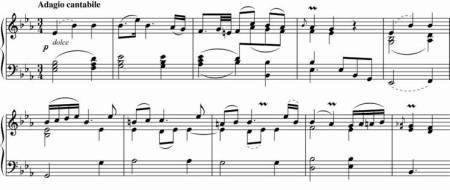 Example 8 Joseph Haydn, String Quartet in C minor op. 17, no. 4, 3rd movement, Adagio cantabile, mm. 1–10
Example 8 Joseph Haydn, String Quartet in C minor op. 17, no. 4, 3rd movement, Adagio cantabile, mm. 1–10
Just to make things even more complicated, the slow movement of the trio sonata in B-flat major H 584/Wq 158 by Carl Philipp Emanuel Bach, a Largo in ¾ time, introduces the same six note motif also in E-flat major (this is the only work in E-flat I have been able to locate references to in the literature as a possible source for Mozart’s motif, see e.g. Hermann Abert 1955/56, I, p. 364; however, there is no evidence that Mozart actually knew it). A further instance of the motif in an opera by Paisiello – this time in F major – is referred to by several authors (see Abert 1955/56, I, p. 364; the source in Paisiello’s works is not mentioned).
Which of these three E-flat major movements should be regarded as ‘the’ model for the motif occurrences in Mozart’s works (the F major variant by Paisiello is hardly to be considered seriously in this regard)? There is no unequivocal answer to this question, however, taking into account that none among Mozart’s instances in Table 1 is in ¾ time, Johann Christian Bach’s Andantino (see Example 7) seems the most likely candidate. This hypothesis has, however, a major flaw: the occurrence in Bach’s movement resembles the instances in K.205 (A major) and K.203 (G major) much more than the first instance in E-flat major among Mozart’s works, namely K.171, with its solemn, somewhat rigid quarter notes. Only as late as the aria from Idomeneo does Mozart attain a comprehensive typological resemblance to the melody of Bach’s Andantino, at the same time also sharing its key.
The fact that each of the three ‘foreign’ E-flat major movements mentioned above may theoretically account for Mozart’s employing the six tone motif mainly in this key is rather puzzling in view of the thesis presented here. Is the affinity between motif and key not a Mozart-specific phenomenon after all? Was Mozart following here a much broader ‘fashion’ of his time? And does this imply that key dependent structural elements might constitute a much more common practice than writers on key characteristics have hitherto suspected? In this context, Alfred Heuß’ reference to the motif in terms of a “true E-flat major idea” (1930/31, pp. 188–189) seems symptomatic.
However, restricting the field of enquiry to Mozart, it may be possible to interpret the correlation between key and structure in his works as a consequence of his extraordinary musical gifts. The following explanation has been suggested – probably for the first time – by Wilhelm Gloede:
Owing to his absolute pitch, Mozart surely conceived his musical ideas not in an abstract tonal space, but rather in connection with concrete keys, and also his memory will have functioned in this way. (Gloede 1993, pp. 40–41, author’s translation)
Considering Mozart’s well documented absolute pitch as well as his phenomenal memory, it seems quite plausible that his musical thinking was basically key-oriented, and that this was responsible for the emergence of a Mozart-typical correlation between keys and specific musical material in his works. The various instances of the six tone motif are, indeed, hardly enough evidence in order to support a general theory, however, these findings seem to fit into a larger perspective of Mozart as a key-bound composer (more results, regarding key dependent melodic, harmonic and formal phenomena in Mozart’s works, will be included in the author’s forthcoming dissertation on Key dependent elements in Mozart’s music). The highly non standardized situation regarding pitch and tuning systems during Mozart’s lifetime (it is well known that Mozart and his contemporaries were exposed to ‘differently pitched’ keys depending on the city and on the instruments involved) poses a serious challenge for this thesis, without, however, discrediting it.
How a certain motif may have found its way into Mozart’s repertory and establish a long-term relation to a certain key is a question that cannot be completely resolved, since we shall never have a complete knowledge of the works Mozart knew and was influenced by. However, staying within the boundaries of Mozart’s works, these seem to tell a story of their own. Deducing from the six note motif as to the nature of Mozart’s oeuvre in general, key dependent elements seem to play in it a non-negligible role.
Bibliography
Abert, Hermann (1955/56), W.A. Mozart. Neubearbeitete und erweiterte Ausgabe von Otto Jahns Mozart, 3rd edition (7th edition of the biography by Jahn), Leipzig: Breitkopf & Härtel.
Auhagen, Wolfgang (1983), Studien zur Tonartencharakteristik in theoretischen Schriften und Kompositionen vom späten 17. bis zum Beginn des 20. Jahrhunderts, Frankfurt a.M. etc.: Lang.
Bär, Carl (1963), »Die ›Andretterin-Musik‹. Betrachtungen zu K.205«, Acta Mozartiana 10/2, 30–37.
Bockholdt-Weber, Petra (1990), »B-Dur und D-Dur bei Beethoven«, in: Festschrift Rudolf Bockholdt zum 60. Geburtstag, ed. by Norbert Dubowy and Sören Meyer-Eller, Pfaffenhofen: Ludwig, 321–338.
––– (2003), »F-Dur in Mozarts Opern«, in: Bericht über das Mozart-Symposion zum Gedenken an Wolfgang Plath (1930–1995), ed. by Marianne Danckwardt and Wolf-Dieter Seiffert, Kassel etc.: Bärenreiter.
Brügge, Joachim (1992), »Joseph Haydn, op. 20 Nr. 2, Capriccio – eine Vorlagekomposition für W.A. Mozart, K.171, I«, Neues musikwissenschaftliches Jahrbuch 1, 69–86.
Chusid, Martin (1968), »The Significance of D Minor in Mozart’s Dramatic Music«, Mozart-Jahrbuch 1967,87–93.
Derr, Ellwood (1997), »Composition with Modules. Intersections of Musical Parlance in Works of Mozart and J.C. Bach«, Mozart-Jahrbuch 1997, 249–291.
Finscher, Ludwig (1985), »Mozart und die Idee eines musikalischen Universalstils«, in: Die Musik des 18. Jahrhunderts (= Neues Handbuch der Musikwissenschaft 5), ed. by Carl Dahlhaus, Laaber: Laaber, 267–278.
Fladt, Hartmut (2005), »Modell und Topos im musiktheoretischen Diskurs. Systematiken/Anregungen«, Musiktheorie 20/4, 343–369.
Gloede, Wilhelm (1993), »Motivstruktur und Tonart bei Mozart«, Archiv für Musikwissenschaft 50/1, 26–43.
Hand, Ferdinand (1837), Ästhetik der Tonkunst, vol. 1, Leipzig: C. Hochhausen & Fournes.
Haynes, Bruce (2002), A History of Performance Pitch – the Story of »A«, Lanham: The Scarecrow Press, Inc.
Heuß, Alfred (1930/31), »Mozarts Idomeneo als Quelle für Don Giovanni und Die Zauberflöte«, Zeitschrift für Musikwissenschaft 13, reprint Wiesbaden: Breitkopf & Härtel 1971, 177–199.
Hyatt-King, Alec (1937), »The Consistency of Mozart’s Use of Keys«, The Monthly Musical Record 67, 104–107.
Jahn, Otto (1856–59), W.A. Mozart, 4 Vols., Leipzig: Breitkopf & Härtel.
Jan, Steven B. (1995), Aspects of Mozart’s Music in G Minor. Toward the Identification of Common Structural and Compositional Characteristics, New York etc.: Garland Publishing.
Kaiser, Ulrich (2007), Die Notenbücher der Mozarts als Grundlage der Analyse von W.A. Mozarts Kompositionen 1761–1767, Kassel etc.: Bärenreiter.
Koch, Heinrich Christoph (1782–93), Versuch einer Anleitung zur Composition, 3 vols., Rudolstadt and Leipzig: Adam Friedrich Böhme, reprint Hildesheim etc.: Olms 2000.
Konrad, Ulrich (2005), Wolfgang Amadé Mozart. Leben. Musik. Werkbestand, Kassel etc.: Bärenreiter.
Lüthy, Werner (1931), Mozart und die Tonartencharakteristik (= Sammlung musikwissenschaftlicher Abhandlungen3), Strassburg: Heitz & Cie., reprint Baden-Baden: Koerner 1974.
Mattheson, Johann (1713), Das neu-eröffnete Orchestre, Hamburg: der Author and Benjamin Schiller’s Widow, reprint Laaber: Laaber 2002.
Mies, Paul (1948), Der Charakter der Tonarten, Köln etc.: Staufen.
Mozart, Leopold (1756), Versuch einer gründlichen Violinschule, Augsburg: Johann Jacob Lotter.
Plath, Wolfgang (1966), »Vorwort« in: NMA (= Neue Mozart-Ausgabe = Wolfgang Amadeus Mozart. Neue Ausgabe sämtlicher Werke, in Verbindung mit den Mozartstädten Augsburg, Salzburg und Wien hg. von der Internationalen Stiftung Mozarteum Salzburg, 10 Serien, Kassel u.a.: Bärenreiter 1955ff), VIII/20, Abt. 1/1 (String Quartets vol. 1).
––– (1984), »Chronologie als Problem der Mozartforschung«, in: Bericht über den Internationalen musikwissenschaftlichen Kongreß Bayreuth 1981, ed. by Christoph-Hellmut Mahling and Sigrid Wiesmann, Kassel etc.: Bärenreiter, 371–378.
Quantz, Johann Joachim (1752), Versuch einer Anweisung die Flöte traversiere zu spielen, Berlin: Johann Friedrich Voß, reprint München etc.: dtv/Bärenreiter 1992.
Riepel, Joseph (1755), Grundregeln zur Tonordnung insgemein […], Frankfurt and Leipzig, reprint in: Joseph Riepel. Sämtliche Schriften zur Musiktheorie (= Wiener Musikwissenschaftliche Beiträge 20), ed. by Thomas Emmerig, Wien etc.: Böhlau 1996, 101–237.
Rosen, David (1996), »›Unexpectedness‹ and ›Inevitablility‹ in Mozart’s Piano Concertos«, in: Mozart’s Piano Concertos. Text, Context, Interpretation, ed. by Neal Zaslaw, Michigan: University of Michigan Press, 261–284.
Schilling, Gustav (1835–38), Articles: »A-Dur« to »h-Moll«, in: id., Encyclopädie der gesammten musikalischen Wissenschaften, oder Universal-Lexicon der Tonkunst, vol. 1–3, Stuttgart: Köhler.
Schubart, Christian Friedrich Daniel (1806), Ideen zu einer Ästhetik der Tonkunst, ed. posthumously by Ludwig Schubart, Wien: Degen, re-edited by P.A. Merbach, Leipzig: Wolkenwanderer.
Schwindt-Gross, Nicole (1989), Drama und Diskurs: Zur Beziehung zwischen movementtechnik und motivischem Prozeß am Example der durchbrochenen Arbeit in den String Quarteten Mozarts und Haydns (= Neue Heidelberger Studien zur Musikwissenschaft 15), Laaber: Laaber.
Souper, F.O. (1933), »Mozart and Tonality«, The Monthly Musical Record 63, 202–203.
Steblin, Rita (1981), A History of Key Characteristics in the Eighteenth and Early Nineteenth Centuries, reprint Rochester, New York: University of Rochester Press, 1996.
Tenschert, Roland (1953), »Die g-Moll-Tonart bei Mozart«, Mozart-Jahrbuch 1951, 112–122.
Tusa, Michael C. (1993), »Beethoven’s ›C-Minor Mood‹: Some Thoughts on Structural Implications of Key Choice«, Beethoven Forum 2, 1–27.
Ulibischeff, Alexander (1859), Mozart’s Leben und Werke, 2nd edition, revised and extended edition by Ludwig Gantter, 4 vols., Stuttgart: Carl Conradi.
Tyson, Alan (1987), Mozart. Studies of the Autograph Scores, Cambridge etc.: Harvard University Press.
Vetter, Isolde (1998), »Mozarts Nachschrift des Allegrischen Miserere: Ein Gedächtnis-›Wunder‹«, in: Musik als Text: Bericht über den internationalen Kongress der Gesellschaft für Musikforschung, ed. by Hermann Danuser and Tobias Plebuch, Kassel etc.: Bärenreiter, 144–147.
Warburton, Ernest (1984), »Introduction«, in: Symphonies 1st Twelve Early Symphonic Works from Eighteenth-Century Printed Sources (= The Collected Works of Johann Christian Bach 1735–1782 26), ed. by Ernest Warburton, New York etc.: Garland Publishing, Inc.
Webster, James (1991), Haydn’s ›Farewell‹ Symphony and the Idea of Classical Style: Through-Composition and Cyclic Integration in His Instrumental Music, Cambridge etc.: Cambridge University Press.
















